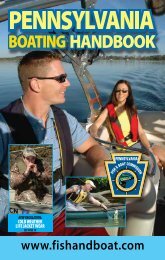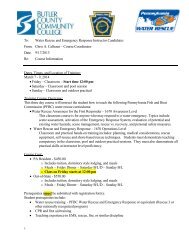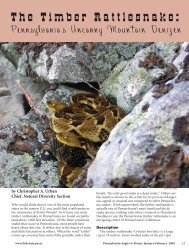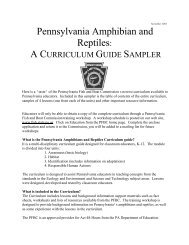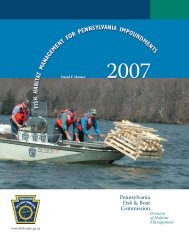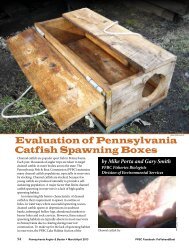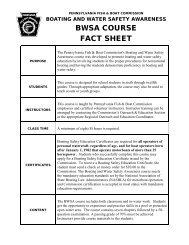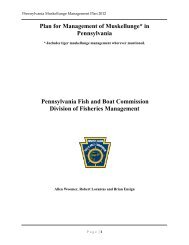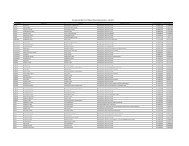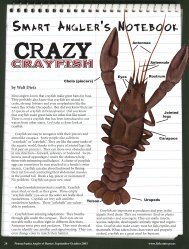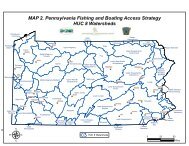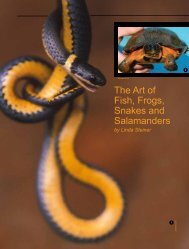june 1963 boating issue - Pennsylvania Fish and Boat Commission
june 1963 boating issue - Pennsylvania Fish and Boat Commission
june 1963 boating issue - Pennsylvania Fish and Boat Commission
You also want an ePaper? Increase the reach of your titles
YUMPU automatically turns print PDFs into web optimized ePapers that Google loves.
THE WORM WALLET<br />
By ARTHUR GLOWKA<br />
Rubber worms, eels <strong>and</strong> lead-headed jigs are proven bass<br />
"ers. Many fishermen use these bottom-bouncing lures ex-<br />
Usively with great success. Carrying these lures, especially<br />
le<br />
eels <strong>and</strong> worms, presents a problem because they often stick<br />
Sether <strong>and</strong> become more tangled than a bait can full of their<br />
ea<br />
' life counterparts.<br />
I he solution is to make a simple worm wallet. It not only<br />
e<br />
Ps the rubber worms, eels <strong>and</strong> jigs separated, <strong>and</strong> their<br />
°°ks sharp <strong>and</strong> clean, but also allows the fisherman to h<strong>and</strong>ily<br />
rr<br />
y them in his tackle box, fishing" vest or hip pocket.<br />
•Two worm wallets can be made from a dollar's worth of<br />
ail<br />
vas <strong>and</strong> some simple machine sewing. A worm wallet of<br />
J^ e size described carries 5, 6, <strong>and</strong> 7-inch worms <strong>and</strong> eels.<br />
ne<br />
Jig pockets accommodate jigs as large as would ever be<br />
Se<br />
d in fresh-water fishing.<br />
The fabric to buy is 10-oz. treated (waxed) deck canvas. A<br />
la<br />
'f a yard of this material costs less than a dollar at the hardar<br />
e store <strong>and</strong> is enough to make two worm wallets. Untreated<br />
canvas or any heavy material can be used but will not be as<br />
"ft nor as waterproof. Treated canvas is the best bet.<br />
The half yard of canvas is first cut into equal pieces measuring<br />
° inches on each side. Then the outline of the wallet is penciled<br />
° n following the dimensions shown in picture No. 1. These<br />
" le s must be drawn straight <strong>and</strong> square so the finished wallet<br />
VV<br />
'U fold neatly.<br />
Sharp scissors or a razor should be used to cut the material.<br />
e<br />
careful to cut straight so there are no serrations which cause<br />
'Celling.<br />
Before folding the top <strong>and</strong> bottom flaps, the fold should be<br />
^ored along the dotted line (Picture No. 1) with a blunt tool,<br />
.he back edge of a table knife works very well. This scoring<br />
'Usures a clean fold with a straight edge which is easy to sew.<br />
After the top <strong>and</strong> bottom flaps have been folded inward the<br />
Suide lines for sewing the pockets are drawn. Starting from<br />
" e right these lines are spaced V/2 inches apart as shown in the<br />
3<br />
°ttom of picture No. 1. This makes nine pockets with a V/2"<br />
" a P on the left which is used for closing the wallet.<br />
Unless you are a sewing machine operator you are going to<br />
as<br />
k your wife to do some simple sewing on her machine. Size<br />
4<br />
"°. 50 sewing thread works very well. The right <strong>and</strong> left edges<br />
Ca<br />
" be sewn with a button hole stitch to prevent ravelling.<br />
he pockets are sewn with a regular stitch, sewing each seam<br />
{<br />
*ice to make it strong.<br />
The extra jig pocket is an optional feature. It allows you<br />
'° carry extra jigs but in no way will interfere with using the<br />
to<br />
P <strong>and</strong> bottom pockets in this area for worms <strong>and</strong> eels.<br />
The only thing left to do is sewing on a No. 2 snap; first<br />
Waking sure that both parts of the snap line up when the wallet<br />
Is<br />
folded close. This is easily done by folding the wallet in three<br />
e(<br />
lUal folds <strong>and</strong> sticking a large pin completely through the can-<br />
Va<br />
s where the snaps are to go <strong>and</strong> then using these holes to<br />
Ce<br />
nter them.<br />
The worm wallet is complete except for the lures. The worms<br />
a<br />
°d eels are placed in their pockets by first opening each pocket<br />
Vv<br />
'th your finger <strong>and</strong> slipping in the end of the lure. They can't<br />
"tove or slip because of the pressure of the canvas against<br />
'hem. One jig-headed worm or rigged eel fits perfectly into<br />
ea<br />
ch pocket. Extra unrigged worms <strong>and</strong> eels can be fitted two<br />
an<br />
d three to a pocket.



